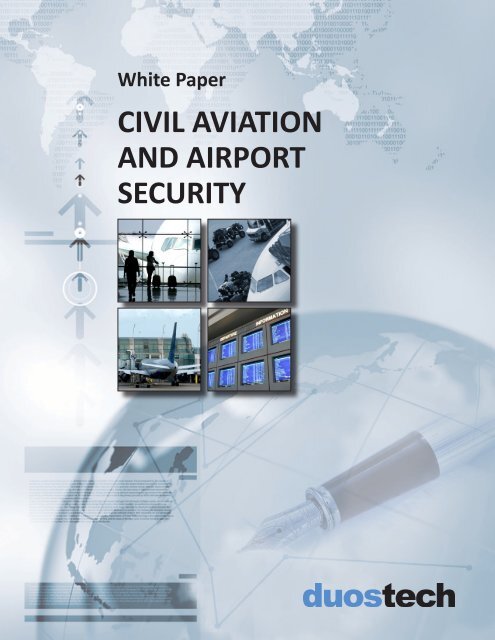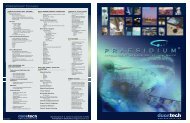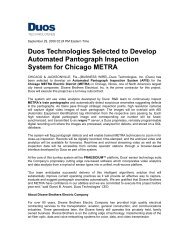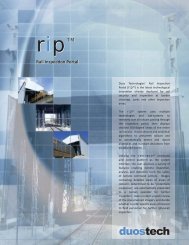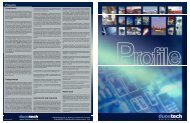civil aviation and airport security white paper - Duos Technologies
civil aviation and airport security white paper - Duos Technologies
civil aviation and airport security white paper - Duos Technologies
You also want an ePaper? Increase the reach of your titles
YUMPU automatically turns print PDFs into web optimized ePapers that Google loves.
White Paper<br />
CIVIL AVIATION<br />
AND AIRPORT<br />
SECURITY
<strong>Duos</strong> <strong>Technologies</strong>, Inc.<br />
CIVIL AVIATION AND AIRPORT SECURITY<br />
WHITE PAPER<br />
BY<br />
CHARLES GOSLIN<br />
“Charles Goslin, Vice President of International Operations for <strong>Duos</strong> <strong>Technologies</strong>, Inc., is an<br />
international expert in <strong>security</strong> threat <strong>and</strong> risk assessment. He developed his extensive <strong>security</strong><br />
experience as a veteran operations officer for 27 years with the Central Intelligence Agency. He is<br />
skilled in developing <strong>and</strong> executing programs targeting terrorism, espionage, weapons<br />
proliferation, <strong>and</strong> other select U.S. national <strong>security</strong> objective. He brings a unique, ground-level<br />
perspective to <strong>security</strong> challenges that can only come from a lifetime spent mitigating risk, in all its<br />
forms, while living <strong>and</strong> working abroad.<br />
His most recent assignment, before joining <strong>Duos</strong>, was as a senior advisor to the Regional Joint<br />
Terrorism Task Forces (JTTF) in the U.S. In addition to Mr. Goslin’s current work with international<br />
clients, he has authored professional articles <strong>and</strong> undertaken public speaking engagements<br />
regarding the evolution of physical <strong>security</strong> in the 21 st century, <strong>and</strong> how it can better secure critical<br />
infrastructure for public <strong>and</strong> private enterprise.”
<strong>Duos</strong> <strong>Technologies</strong>, Inc.<br />
THIS PAGE INTENTIONALLY LEFT BLANK<br />
Page 2 of 11 CIVIL AVIATION AND AIRPORT SECURITY WHITE PAPER 11/12/2008
<strong>Duos</strong> <strong>Technologies</strong>, Inc.<br />
INTRODUCTION<br />
The unrelenting terrorism threat to the<br />
commercial <strong>aviation</strong> industry is one of the most<br />
visible <strong>security</strong> challenges to authorities,<br />
worldwide, today. Since the early 1970’s, there<br />
have been consistent terrorist attacks on airlines<br />
<strong>and</strong> the traveling public around the world 1 . In<br />
the U.S., these attacks frequently took the form<br />
of airliner hijacking; internationally, incidents<br />
included hijackings <strong>and</strong> attacks on the <strong>airport</strong><br />
terminals <strong>and</strong> passengers themselves 2 , attacks<br />
on airliners in the taxiway or at the gate 3 , <strong>and</strong><br />
even buses transporting airline personnel 4 . The<br />
reaction to this ongoing, evolving threat over<br />
the years has varied, depending on whether the<br />
incident was in the U.S. or abroad. In the U.S.,<br />
the focus of <strong>security</strong> has been principally on<br />
checkpoint screening technology, procedure,<br />
<strong>and</strong> management. Abroad, <strong>security</strong> forces focus both on checkpoint screening, <strong>and</strong> on the<br />
passengers themselves. In either case, whether it is a small regional <strong>airport</strong> or London’s Heathrow<br />
Airport, the effect for passengers feels the same: a formidable “iron curtain” of guards <strong>and</strong> <strong>security</strong><br />
procedures stifling any notion of traveler convenience.<br />
Whether the focus of <strong>security</strong> doctrine applied at an <strong>airport</strong> is to keep dangerous objects off the<br />
aircraft or dangerous people out of the <strong>airport</strong>, the design of engineering <strong>and</strong> technical upgrades<br />
to <strong>airport</strong>s in the U.S. <strong>and</strong> around the world must ensure that <strong>security</strong> plays an integral role<br />
throughout the planning process. Security planning, in turn, must recognize that the threat<br />
environment is evolving <strong>and</strong> ensure that technology <strong>and</strong> counterintelligence measures anticipate<br />
the terrorists’ next move. In short, <strong>aviation</strong> <strong>security</strong> authorities <strong>and</strong> intelligence authorities must<br />
communicate clearly with each other.<br />
There are many different kinds of <strong>airport</strong>s around the world <strong>and</strong> the <strong>aviation</strong> industry itself is<br />
dynamic <strong>and</strong> diverse. For <strong>security</strong> to be effective in this environment, it ought to be scalable <strong>and</strong><br />
flexible enough to be customized to each kind of facility, <strong>and</strong> its unique requirements. Today, there<br />
are many different technical solutions to <strong>airport</strong> <strong>security</strong> in pilot programs around the U.S. <strong>and</strong><br />
1 21 February 1970, Popular Front for the Liberation of Palestine (PLFP) claims responsibility for mid-air<br />
bombing of Swissair flight 330, near Zurich. U.S. National Counterterrorism Center Worldwide Incident Tracking System.<br />
2 Suicide <strong>and</strong> grenade attacks in passenger terminals by Abu Nidal terrorist groups at Rome <strong>and</strong> Vienna <strong>airport</strong>s,<br />
leaving 16 dead <strong>and</strong> 100 injured. U.S. Department of State, significant terrorist incidents, 1961-2003, a brief chronology<br />
(www.state.gov/r/pa/ho/pubs/fs/5902.htm)<br />
3 17 December 1973 terrorist attack on Pan American Airlines flight 110, while it was preparing for departure, at<br />
Rome Airport. 29 persons were killed. Ibid.<br />
4 10 February 1970 PFLP attack on El Al bus at Munich Airport. One passenger killed <strong>and</strong> 11 injured. Ibid.<br />
Page 3 of 11 CIVIL AVIATION AND AIRPORT SECURITY WHITE PAPER 11/12/2008
<strong>Duos</strong> <strong>Technologies</strong>, Inc.<br />
internationally. Each, in its own specific sphere, addresses a piece of the puzzle. One size, however,<br />
does not fit all, <strong>and</strong> fragmented technology creates more problems rather than solutions.<br />
The future of <strong>aviation</strong> <strong>and</strong> <strong>airport</strong> <strong>security</strong> is in well<br />
trained <strong>security</strong> personnel, procedures, <strong>and</strong><br />
technology systems that integrate <strong>and</strong> orchestrate<br />
<strong>security</strong> solutions into one highly effective pro-active<br />
response to the terrorists who are plotting an attack<br />
<strong>and</strong> assessing <strong>airport</strong>s vulnerabilities.<br />
THE THREAT<br />
International Airport<br />
Terrorists have long favored an attack on <strong>civil</strong> <strong>aviation</strong>; in a risk versus gain analysis, the return for<br />
a potentially successful attack is much higher than for other targets. A successful hijack of an<br />
airliner, its crew, <strong>and</strong> passengers ensures immediate international attention to political dem<strong>and</strong>s,<br />
or grievances. When an airliner is hit, revenge is exacted <strong>and</strong> a heavy, fearful price is paid as we<br />
witness the aircraft <strong>and</strong> passengers’ destruction in graphic horror. Most experts are familiar with<br />
these tactics <strong>and</strong> have crafted defeat measures to mitigate these concerns; however, <strong>security</strong><br />
manpower <strong>and</strong> technology remain fragmented, mismanaged, <strong>and</strong> under-utilized.<br />
Terrorism has evolved to a new lethal level; as defeat measures are crafted, terrorists assess weak<br />
spots <strong>and</strong> vulnerabilities to plot a future attack. An example is the 2006 foiled plot in London to<br />
take liquid explosives on airlines. Terrorists know they are succeeding in negatively affecting the<br />
psyche of the average, law-abiding citizen <strong>and</strong> the financial loss of the airline industry by creating<br />
fear, inconvenience, <strong>and</strong> long delays.<br />
The following incidents over the past decade are just a few examples of the continued focus of<br />
terrorism against <strong>aviation</strong>:<br />
10 December 1994 - Bombing aboard Philippine Airlines flight 434, which killed a<br />
Japanese businessman. It was a small explosion, <strong>and</strong> a test run for operation<br />
“Bojinka,” an Al Qaeda plan to blow up at least 12 transpacific flights. The Manila<br />
police discovered <strong>and</strong> foiled this plot. 5<br />
Philippine Airlines flight 434<br />
5 World Trade Center (WTC) bomber Ramzi Yousef planted the bomb on the aircraft as a test for a larger plan to<br />
bomb 11 airliners. On 6 January 1995, he was arrested by Manila police after explosives accidently ignited in his<br />
apartment, causing a fire. The plan was discovered on a laptop in his apartment.<br />
Page 4 of 11 CIVIL AVIATION AND AIRPORT SECURITY WHITE PAPER 11/12/2008
<strong>Duos</strong> <strong>Technologies</strong>, Inc.<br />
11 September 2001 - Attacks by suicide terrorists hijacking four airliners,<br />
targeting the World Trade Center in New York, the Pentagon, <strong>and</strong> U.S. Capitol<br />
building (the fourth hijacking was thwarted by<br />
passengers who assaulted the hijackers on the<br />
plane). This watershed event demarcates the era<br />
of airline hijacking-for-concession tactics, from<br />
the current era of hijacking airliners for use as a<br />
weapon of mass destruction (WMD) <strong>and</strong> terror.<br />
World Trade Center<br />
memorial lights<br />
World Trade Center Ground Zero<br />
six months after 11 September 2001<br />
22 December 2001 - Richard Reid arrested for attempting to destroy<br />
American Airlines flight 63, from Paris to Miami, by igniting<br />
explosives hidden in his shoe.<br />
November 2002 – Al Qaeda-planned attempt to shoot down an Israeli airliner, using shoulder-fired<br />
missiles in Mombasa, Kenya. 6<br />
4 September 2004 - Los Angeles International Airport (LAX) shut down for several hours after a<br />
man, waving boarding passes, went the wrong way up the exit stairs of the<br />
United Airlines baggage claim area into the secure area of the terminal.<br />
10 August 2006 - Discovery of a terror plot by British authorities aimed at<br />
detonating liquid explosives on flights originating from U.K. <strong>and</strong> the U.S. 7<br />
Richard Reid with his explosives shoe<br />
3 June 2007 - JFK International Airport terrorist plot thwarted. The<br />
objective was to destroy the fuel supply system for the <strong>airport</strong>.<br />
Armed police patrol<br />
Manchester Airport amid<br />
heightened <strong>security</strong><br />
30 June 2007 - Glasgow, Scotl<strong>and</strong> International <strong>airport</strong> terminal<br />
attacked by a VBIED that failed to explode.<br />
5 October 2007 - Loaded gun found in the men’s restroom past the<br />
<strong>security</strong> “hardline” at Tucson International Airport, which forced the<br />
evacuation of the west concourse.<br />
Strela SA-7 missiles (MANPADs) used<br />
against airliner<br />
6 Two SA-7 Strela 2 shoulder-fired missiles (MANPAD-SAM) launched at Arkia Airlines Boeing 757 carrying 261<br />
passengers to Israel; the attackers positioned themselves outside the perimeter of the <strong>airport</strong>, near the runway. Six<br />
additional MANPADs were found at the scene.<br />
7 This plot had the hallmarks of the failed 1995 “Bojinka” plot, which was an Al Qaeda plan to use liquid<br />
explosives smuggled aboard airliners, to subsequently bring them down over the Pacific Ocean. This plot reinforced the<br />
point that terrorists – particularly Al Qaeda – do not necessarily ab<strong>and</strong>on a strategy just because it failed the first time.<br />
Page 5 of 11 CIVIL AVIATION AND AIRPORT SECURITY WHITE PAPER 11/12/2008
<strong>Duos</strong> <strong>Technologies</strong>, Inc.<br />
VULNERABILITIES<br />
Airport <strong>security</strong> will remain in the calculus of terrorist planners so long as <strong>civil</strong> <strong>aviation</strong> is a target of<br />
attack. It is the access point for aircraft on the ground, passengers, <strong>airport</strong> <strong>and</strong> aircraft ground<br />
support personnel, <strong>and</strong> key personnel who have routine access behind the <strong>security</strong> checkpoint<br />
“hardline.” The following are some key vulnerabilities to areas of an <strong>airport</strong>:<br />
Perimeter of airfield: Access to the airfield is often poorly monitored, particularly along the far<br />
reaches of the fenceline around an airfield. There may be CCTV coverage, but due to the size of the<br />
field, coverage does not overlap, <strong>and</strong> monitoring of the live feed occurs only in support of a<br />
physical patrol in the area. Access from these areas can be gained to aircraft tied down on hardst<strong>and</strong>s,<br />
or support vehicles used to service aircraft, simply by breaching the fence at isolated<br />
points. Access can also be gained via drainage pipes or conduit leading beneath fencelines to<br />
runoff sluices.<br />
Ground Operations zone of <strong>airport</strong>: This is the zone between the terminal <strong>and</strong> the taxiway <strong>and</strong><br />
runways. It is a very busy <strong>and</strong> cluttered area that includes aircraft parked at hard-st<strong>and</strong>s <strong>and</strong> at<br />
gates, baggage/stair tugs, guide vehicles, airline crew, baggage h<strong>and</strong>lers, food service personnel,<br />
maintenance personnel…the list is long. It is very difficult to secure, because it is so dynamic in<br />
nature.<br />
Ticketing <strong>and</strong> departure area of terminal: These are publicly accessible areas that are lightly<br />
guarded at best, <strong>and</strong> relatively unmonitored. It is also a very vulnerable area for the traveling<br />
public. It is an easy place for a specific ethnic group<br />
or nationality to be targeted, while queuing for their<br />
national airline or a flight destination to their<br />
country of origin. Also, it is in this area of the <strong>airport</strong><br />
where a terrorist with a plan to get through<br />
<strong>security</strong>, <strong>and</strong> onto an aircraft, puts on his “game<br />
face. 8 ” Any last vestige of nervousness, or<br />
apprehension about what is intended, will manifest<br />
itself at the ticket counter, either when answering<br />
specific <strong>security</strong> questions, or waiting in the <strong>security</strong><br />
Ticket area of an <strong>airport</strong> terminal<br />
screening queue.<br />
Screening area: Screening technology has improved the system, but there remain major gaps that<br />
need to be closed. One such gap is screening for non-metallic items under clothing, such as<br />
ceramic knives, or body-conforming plastique explosive.<br />
Airport employee vetting: In the planning phase of a criminal or terrorist operation, groups<br />
initially explore the opportunity to plant or recruit one or more employees in an <strong>airport</strong> facility to<br />
8 The great majority of El Al passengers are classified as low risk <strong>and</strong> subjected to a routine level of <strong>security</strong>.<br />
About 1%, however, are flagged as high risk because they are on a government watch list or appear nervous at the<br />
checkpoint, or because their answers or behavior arouse suspicion. Strategies for Countering Terrorism, Lessons from the<br />
Israeli Experience, March 2003.<br />
Page 6 of 11 CIVIL AVIATION AND AIRPORT SECURITY WHITE PAPER 11/12/2008
<strong>Duos</strong> <strong>Technologies</strong>, Inc.<br />
assist <strong>and</strong> facilitate the surveillance <strong>and</strong> the actual attack, or criminal act, itself. Their surveillance,<br />
in this initial phase, usually neutralizes most of the adopted <strong>security</strong> procedures <strong>and</strong> allows the<br />
group to devise an efficient scheme to launch the attack. Individuals with physical access to the<br />
aircraft, such as baggage h<strong>and</strong>lers, ground staff, or airline ticket counter staff, are given only<br />
cursory background checks for their minimum-wage level jobs; this is a particularly acute problem<br />
at so-called “spoke” or “feeder” <strong>airport</strong>s, because it leaves them critically vulnerable to<br />
recruitment by criminal, or terrorist groups.<br />
COUNTERMEASURES AND TECHNOLOGY SOLUTIONS<br />
The combination of state-of-the-art technology with well trained <strong>security</strong> personnel <strong>and</strong><br />
procedures provides effective, proven solutions to securing <strong>airport</strong>s with efficiency. The cost of<br />
upgrading <strong>airport</strong>s with the latest technologies will be offset by maintaining the safety of the<br />
<strong>airport</strong>’s infrastructure <strong>and</strong> continuous uninterrupted flow of air traffic <strong>and</strong> air travelers. The<br />
interrupted flow of air traffic <strong>and</strong> air travelers <strong>and</strong> the cost of damaged <strong>airport</strong> infrastructure can<br />
result in millions of dollars lost in a very short period.<br />
Counterintelligence<br />
A major vulnerability in <strong>airport</strong> <strong>security</strong> is the neglected ‘human factor’ – giving minimum wage<br />
<strong>and</strong> lightly-vetted <strong>airport</strong> (or airline) workers access to the flight-line. A very important component<br />
in designing any <strong>airport</strong>’s <strong>security</strong> system is counterintelligence. If neglected, the overall integrity<br />
of the <strong>airport</strong>’s <strong>security</strong> systems is severely undermined, compromising the efficiency of any<br />
<strong>security</strong> technologies. Therefore, in any design of a <strong>security</strong> solution, counterintelligence measures<br />
<strong>and</strong> procedures must be well devised <strong>and</strong> clearly mapped in order to make the solutions effective<br />
as desired.<br />
Effective counterintelligence measures to address the ‘human factor’ include:<br />
Specialized training for <strong>airport</strong> <strong>security</strong> personnel <strong>and</strong> screeners<br />
Security response procedures <strong>and</strong> ‘red teaming’ operations<br />
Security background check of all <strong>airport</strong> employees <strong>and</strong> close monitoring of<br />
their behavior<br />
Zoning (no-go <strong>and</strong> limited access zones for employees)<br />
Security check of all outside contractors, regardless of escort by <strong>airport</strong><br />
employees<br />
Intelligent Video Surveillance / Tag <strong>and</strong> Track Technology<br />
International Airport<br />
Security<br />
<strong>Duos</strong> <strong>Technologies</strong>’ intelligent video surveillance “tag-<strong>and</strong>-track” technology is extremely useful for<br />
<strong>airport</strong> <strong>security</strong> personnel <strong>and</strong> screeners. It enables the hardening of interior surveillance<br />
operations <strong>and</strong> the ability to maintain a continuous flow of air travelers, resulting in millions of<br />
dollars saved <strong>and</strong> preventing the disruption of <strong>airport</strong> travel. <strong>Duos</strong>’ intelligent video “tag-<strong>and</strong>track”<br />
software enables <strong>security</strong> personnel to discreetly tag <strong>and</strong> track multiple ‘suspect’ individuals<br />
from the screening checkpoint through the concourses to the departure gates in a seamless, real<br />
time video feed which can be played back ‘post event’ <strong>and</strong> fast forwarded into ‘live video feed.’<br />
Page 7 of 11 CIVIL AVIATION AND AIRPORT SECURITY WHITE PAPER 11/12/2008
<strong>Duos</strong> <strong>Technologies</strong>, Inc.<br />
This enables the <strong>security</strong> personnel to covertly monitor ‘suspect’ individuals without causing<br />
disruption or concern amongst air travelers. If a<br />
‘suspect’ requires apprehension, the <strong>security</strong> personnel<br />
will know at all times the exact location of the ‘suspect’<br />
<strong>and</strong> can intercept or detain efficiently.<br />
The intelligent video application is also effectively used<br />
to tag, <strong>and</strong> alert <strong>security</strong> personnel (real time <strong>and</strong><br />
remotely), to individuals loitering in or entering a<br />
restricted zone, to objects left behind, or to identify<br />
<strong>and</strong> apprehend thieves <strong>and</strong> v<strong>and</strong>als. The alarm event<br />
can be analyzed post event, seamlessly moving into<br />
real time to “tag-<strong>and</strong>-track” to the individual<br />
responsible for the alarm event. To date, <strong>Duos</strong> is the<br />
only company operating a proprietary system of this<br />
nature in <strong>airport</strong>s. It has been a proven success.<br />
<strong>Duos</strong> Intelligent Video/Tag <strong>and</strong> Track System<br />
Perimeter Security<br />
Threats from poorly monitored <strong>and</strong> unmonitored perimeters extending beyond runways represent<br />
a significant vulnerability for <strong>civil</strong> <strong>aviation</strong>. A virtual fence system provides a single layer of<br />
protection from physical intrusion onto runway/taxiway operations ‘no go’ areas; early warning of<br />
intrusion is limited, however, <strong>and</strong> there is no ability to distinguish between friend <strong>and</strong> foe.<br />
Virtual fence systems in<br />
<strong>Duos</strong> Three Technology Layers of the Virtual<br />
Security Shield (VSS)<br />
combination with<br />
intelligent video analytics<br />
provide a more robust<br />
solution to perimeter<br />
<strong>security</strong>. <strong>Duos</strong>’ intelligent<br />
video surveillance system<br />
can integrate any number<br />
of sensors to harden<br />
surveillance solutions.<br />
Multi-layered perimeter<br />
<strong>security</strong> is achieved through the combination of intelligent video analytics integrated with ground<br />
radar / sensor scanning systems <strong>and</strong> high resolution fixed <strong>and</strong> PTZ cameras to establish a virtual<br />
fence line that cannot be penetrated. Ground radar can be customized to monitor large, specific<br />
areas well beyond fencelines <strong>and</strong> provide an early warning of suspicious activity, persons, or<br />
vehicles within zones in critical proximity to low-altitude aircraft that are l<strong>and</strong>ing, or taking off. The<br />
<strong>security</strong> software program would automatically vector high-resolution, day-night Pan/Tilt/Zoom<br />
(PTZ) cameras to any suspicious<br />
activity, for subsequent<br />
investigation by <strong>airport</strong> <strong>security</strong><br />
personnel from comm<strong>and</strong> <strong>and</strong><br />
control center or remotely.<br />
Live 360 degree panoramic views<br />
Page 8 of 11 CIVIL AVIATION AND AIRPORT SECURITY WHITE PAPER 11/12/2008
<strong>Duos</strong> <strong>Technologies</strong>, Inc.<br />
To further layer perimeter <strong>security</strong>, a Radio Frequency Identification (RFID) tag would be provided<br />
to authorized <strong>airport</strong> vehicles <strong>and</strong> personnel (which can be coupled with biometrics for personnel,<br />
see details below) to confirm their identify (friend or foe detection) in air operations areas (AOA).<br />
This would also aid in tracking <strong>airport</strong> assets, ensuring that only authorized personnel with a valid<br />
RFID tag were operating vehicles in the area of runways, taxiways, <strong>and</strong> the <strong>airport</strong> perimeters. A<br />
vehicle or individual without a valid RFID tag intruding into a ‘no go’ or restricted-zone in the<br />
vicinity of the <strong>airport</strong> perimeter would be automatically tagged <strong>and</strong> tracked both electronically <strong>and</strong><br />
visually by the system, <strong>and</strong> an audible/visual alert dispatched to <strong>security</strong> officials for immediate<br />
investigation.<br />
Virtual Ground Operations Perimeter<br />
The area between taxiways, runways, <strong>and</strong> the <strong>airport</strong> terminal used by baggage h<strong>and</strong>lers,<br />
cleaning/food service staff, ground operations personnel, designated <strong>airport</strong> employees, <strong>and</strong><br />
aircraft crew members is a busy <strong>and</strong> difficult area to secure.<br />
Using intelligent video analytics, ground operations areas can be divided into segmented,<br />
electronic zones that secure stationary aircraft with a virtual perimeter. Personnel or vehicles<br />
(baggage carts, tugs, buses, etc.) in the ground operations area that have authorized access to the<br />
aircraft would have RFID tags that would confirm their access. Individuals with limited access to<br />
specific airlines, or sectors in the ground operations area, would have tags pre-programmed by<br />
<strong>airport</strong> <strong>security</strong> for specific clearance levels, ensuring they stay within their zone. Anyone<br />
approaching a parked aircraft without an RFID tag, or with an out-of-zone tag, would be<br />
automatically tagged, tracked by video, <strong>and</strong> an audible/visual alert sent to the comm<strong>and</strong> <strong>and</strong><br />
control center.<br />
Biometric Security<br />
Biometric <strong>security</strong> access control ensures that only authorized <strong>airport</strong><br />
<strong>and</strong> airline employees gain access to restricted areas both inside <strong>and</strong><br />
out. Traditional photo identification tags with RFID access codes can<br />
be stolen or “borrowed.” Biometric <strong>security</strong> access control with<br />
retina scanning, h<strong>and</strong> geometry, <strong>and</strong>/or facial recognition systems<br />
prevent criminals <strong>and</strong> terrorists from using the identity of <strong>airport</strong> or<br />
airline personnel to commit illegal acts.<br />
Artist Rendering of Biometric Security<br />
Facial recognition systems can also be employed at <strong>security</strong> checkpoints to alert <strong>and</strong> tag known<br />
individuals on terrorist watch lists, criminal ‘Amber’ alerts, or known fugitives evading authorities.<br />
Coupled with intelligent video/tag-<strong>and</strong>-track software, a positive identification target can be<br />
subsequently tracked by intelligent video, to aid <strong>airport</strong> authorities in investigative follow-up in a<br />
discreet, protected area of the terminal concourse.<br />
Page 9 of 11 CIVIL AVIATION AND AIRPORT SECURITY WHITE PAPER 11/12/2008
<strong>Duos</strong> <strong>Technologies</strong>, Inc.<br />
Weapons Detection System (WDS)<br />
While current technology alerts for metallic objects on individuals passing through a metal<br />
detector, it does not alert for non-metallic objects that could be used in an attack, such as ceramic<br />
knives or plastic explosives. Using weapons detection systems, objects concealed under clothing<br />
can be detected in a passive manner, not compromising the privacy of a person’s anatomy, <strong>and</strong> an<br />
alarm sent covertly to <strong>security</strong> personnel at the screening checkpoint for further investigation.<br />
Weapons detection systems can be integrated into the overall comprehensive intelligent video<br />
surveillance “tag <strong>and</strong> track” solution to provide multilayered <strong>security</strong>. An individual identified by<br />
the WDS system as concealing a weapon or explosive device will be tagged <strong>and</strong> tracked through<br />
the <strong>airport</strong> terminal to enable <strong>security</strong> personnel to investigate <strong>and</strong> quarantine the suspect in a<br />
manner to reduce the risk to passengers <strong>and</strong> screening personnel.<br />
Explosive <strong>and</strong> Chemical Detections<br />
An additional layer of technology that can be integrated into the comprehensive intelligent video<br />
surveillance solution is the detection of explosives <strong>and</strong> chemicals. Many <strong>airport</strong>s are currently<br />
using this technology; however, they aren’t integrating this sensor solution into a broad intelligent<br />
video system. By integrating all <strong>security</strong> <strong>and</strong> surveillance sensors into a comprehensive intelligent<br />
video system, <strong>security</strong> personnel effectively augment overall <strong>security</strong> countermeasures to provide<br />
a multilayered, real time solution that can be utilized in a single comm<strong>and</strong> <strong>and</strong> control capacity <strong>and</strong><br />
with remote capabilities.<br />
DUOS TECHNOLOGIES, INC.<br />
A limited number of <strong>security</strong> technology providers market the solutions referenced<br />
above. <strong>Duos</strong> <strong>Technologies</strong> is unique as it is comprised of defense, intelligence, <strong>and</strong><br />
<strong>security</strong> professionals highly trained in assessing vulnerability <strong>and</strong> risk. An<br />
experienced staff of engineers <strong>and</strong> leading scientists specializing in intelligent video<br />
analytics can jointly craft technology solutions to augment the ‘human factor’ <strong>and</strong><br />
provide multilayered <strong>security</strong> solutions. Our approach is to underst<strong>and</strong> a client’s<br />
<strong>security</strong> challenges, no matter how complex, both through the eyes of the customer<br />
<strong>and</strong> with the in-depth knowledge <strong>and</strong> underst<strong>and</strong>ing of technology, <strong>security</strong>,<br />
terrorism, <strong>and</strong> counterintelligence. We then work h<strong>and</strong>-in-h<strong>and</strong> with customers to<br />
design counterintelligence procedures, train personnel, <strong>and</strong> engineer cutting-edge<br />
technology solutions that fully mitigate risk. <strong>Duos</strong> <strong>Technologies</strong> provides 24/7/365 IT<br />
technical support <strong>and</strong> a full training package.<br />
<strong>Duos</strong> <strong>Technologies</strong> provides a broad range of state-of-the-art, turnkey<br />
technology systems for <strong>security</strong>, surveillance, <strong>and</strong> automation<br />
for the private sector <strong>and</strong> for governments. We are engaged in the<br />
design <strong>and</strong> deployment of customized, artificial-intelligence driven<br />
digital <strong>security</strong> systems integrated with actionable video<br />
surveillance. <strong>Duos</strong> goes well beyond traditional video <strong>security</strong><br />
technology; we distribute digitized sensor <strong>and</strong> video data over open<br />
<strong>Duos</strong> customized browser-based<br />
Graphical User Interface (GUI)<br />
Page 10 of 11 CIVIL AVIATION AND AIRPORT SECURITY WHITE PAPER 11/12/2008
<strong>Duos</strong> <strong>Technologies</strong>, Inc.<br />
IT networks, <strong>and</strong> integrate the information in a customized, browser-based Graphical User<br />
Interface (GUI) that is user-friendly <strong>and</strong> fully centralizes <strong>security</strong> management.<br />
<strong>Duos</strong> <strong>Technologies</strong>’ PRAESIDIUM ® Intelligent Sensor<br />
Detection Suite processes incoming video <strong>and</strong> sensor<br />
feeds utilizing algorithms to detect specific activities<br />
<strong>and</strong> events for <strong>security</strong> <strong>and</strong> surveillance applications.<br />
Combined with intelligent browser-based threedimensional<br />
(3D) mapping software, PRAESIDIUM ®<br />
visualizes suspected <strong>security</strong> breach types <strong>and</strong><br />
locations, simultaneously detecting multiple events<br />
<strong>and</strong> processing/classifying each in accordance with<br />
user-defined parameters. PRAESIDIUM ® has the<br />
lowest false alarm rate in the industry.<br />
The low false alarm rate <strong>and</strong> flexibility of<br />
PRAESIDIUM ® sensor detection suite is one of its<br />
greatest strengths. PRAESIDIUM ® , coupled with the<br />
powerful rvspro server, can incorporate multiple<br />
sensor types, from a simple placement of highresolution,<br />
fixed cameras to a full array of PTZ cameras,<br />
infrared/thermal cameras, ground radar, sensors <strong>and</strong> detectors for<br />
motion, impact, chemical, biological, radiation, explosives, or seismic<br />
activity, as well as biometric tools such as facial recognition, high-speed<br />
retina scanning, or h<strong>and</strong>-geometry. Also, PRAESIDIUM ® hosts<br />
numerous tested, robust intelligent video applications <strong>and</strong> can be<br />
tailored for specific behavior or activity recognition events that merit<br />
<strong>security</strong> concern. Our capabilities can be enhanced integrating Global<br />
Positioning System (GPS) software, RFID, hydrophonics, Optical<br />
Character Readers (OCR), <strong>and</strong> meteorological instrumentation.<br />
Sophisticated <strong>Duos</strong> 3D GUI<br />
Graphic User Interface (GUI) in PDA<br />
<strong>Duos</strong> <strong>Technologies</strong> effectively addresses the ‘human factor.’<br />
CONCLUSION<br />
Airports <strong>and</strong> the <strong>civil</strong> <strong>aviation</strong> industry have been on the front line in the war on terror, long before<br />
9/11. The terrorist threat is an evolving, dynamic issue <strong>and</strong> the tools that <strong>security</strong> authorities need<br />
to confront <strong>and</strong> reduce risk should be designed for tomorrow’s battles <strong>and</strong> not the <strong>security</strong><br />
incidents of last week, or last year. <strong>Duos</strong> <strong>Technologies</strong> is committed to working with customers to<br />
define ill-defined risk, predict the unpredictable, <strong>and</strong> – when the next threat to <strong>security</strong> develops –<br />
be prepared <strong>and</strong> ready to confront <strong>and</strong> manage the risk.<br />
Page 11 of 11 CIVIL AVIATION AND AIRPORT SECURITY WHITE PAPER 11/12/2008
<strong>Duos</strong> <strong>Technologies</strong> , Inc.<br />
6622 Southpoint Dr. S. | Suite 310 | Jacksonville, FL 32216<br />
P/ 904.296.2807 | F/ 904.296.4103 | www.duostech.com | info@duostech.com


